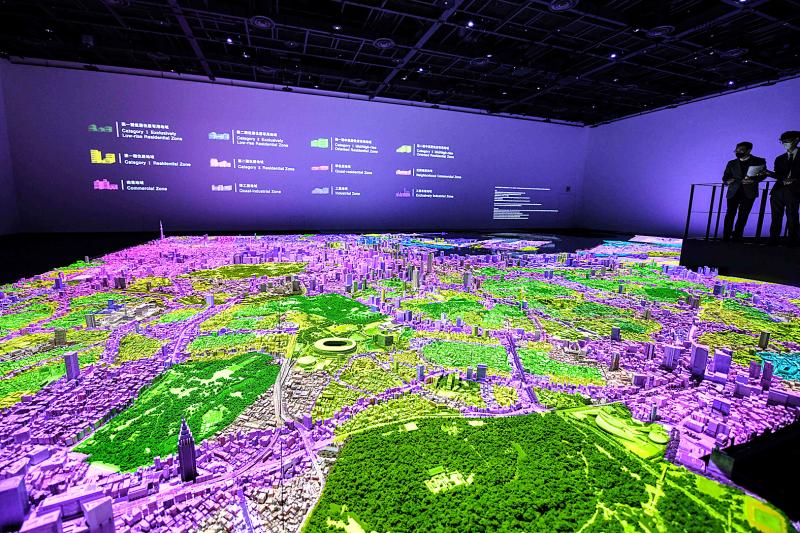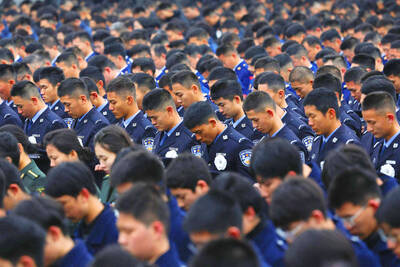It is Tokyo, but unlike you have ever seen it before — a miniaturized 1:1,000 scale version of one of the world’s biggest capitals, displaying everything from sea levels to population densities.
Pairing a 3D model with projection mapping, the Urban Lab project at Tokyo’s Mori Building aims to display information about the Japanese capital in different and visually arresting ways.
“We usually can’t grasp the whole picture of the city in a bird’s-eye view, but looking at it this way, we can see how attractive Tokyo is as well as its challenges,” Shinji Takeda, senior manager at Mori Building, told reporters at the facility.

Photo: AFP
Launched in 2019, the project covering 13 of Tokyo’s 23 districts is intended to help researchers and private developers think about the city.
Visitors can spot landmarks, including the red-and-white Tokyo Tower, and endless apartment blocks in precise 3D detail, replicating a sprawling 230km2.
Projection mapping on top of the model offers a range of information — including how railways intersect with the physical landscape, and where businesses and populations are concentrated.
Road and railway network projections throw into relief the comparatively underdeveloped parts of the megacity, while other visual information depicts Tokyo’s various vulnerabilities.
For example, mapping over the model with altitudes and sea levels illustrates which areas are prone to flooding from rivers, canals and the sea.
Given Japan’s exposure to natural disasters, ranging from earthquakes to typhoons, understanding those vulnerabilities is key, Takeda said.
He cited the example of a massive 2019 typhoon that caused significant flooding along Tokyo’s Tama River.
“We saw the importance of learning how the city has developed in terms of its terrain and which areas are more vulnerable in heavy rain,” he said. “In this facility, you can see not only how earthquakes, but also a variety of other issues affect a disaster-prone Tokyo.”
Tokyo is often considered to be expanding and developing wildly, without a particular plan, in part because earthquake requirements are regularly updated and buildings are overhauled to meet new rules.
The exhibit would keep changing with the city, updated each year to reflect the loss of old buildings and the appearance of new ones.
“Tokyo keeps growing,” Takeda said. “It’s not a city where visitors simply see history as if they’re reading an old textbook.”
“It keeps changing and growing every day, and that is another element of the city that people can enjoy,” he said.

The Burmese junta has said that detained former leader Aung San Suu Kyi is “in good health,” a day after her son said he has received little information about the 80-year-old’s condition and fears she could die without him knowing. In an interview in Tokyo earlier this week, Kim Aris said he had not heard from his mother in years and believes she is being held incommunicado in the capital, Naypyidaw. Aung San Suu Kyi, a Nobel Peace Prize laureate, was detained after a 2021 military coup that ousted her elected civilian government and sparked a civil war. She is serving a

China yesterday held a low-key memorial ceremony for the 1937 Nanjing Massacre, with Chinese President Xi Jinping (習近平) not attending, despite a diplomatic crisis between Beijing and Tokyo over Taiwan. Beijing has raged at Tokyo since Japanese Prime Minister Sanae Takaichi last month said that a hypothetical Chinese attack on Taiwan could trigger a military response from Japan. China and Japan have long sparred over their painful history. China consistently reminds its people of the 1937 Nanjing Massacre, in which it says Japanese troops killed 300,000 people in what was then its capital. A post-World War II Allied tribunal put the death toll

‘NO AMNESTY’: Tens of thousands of people joined the rally against a bill that would slash the former president’s prison term; President Lula has said he would veto the bill Tens of thousands of Brazilians on Sunday demonstrated against a bill that advanced in Congress this week that would reduce the time former president Jair Bolsonaro spends behind bars following his sentence of more than 27 years for attempting a coup. Protests took place in the capital, Brasilia, and in other major cities across the nation, including Sao Paulo, Florianopolis, Salvador and Recife. On Copacabana’s boardwalk in Rio de Janeiro, crowds composed of left-wing voters chanted “No amnesty” and “Out with Hugo Motta,” a reference to the speaker of the lower house, which approved the bill on Wednesday last week. It is

FALLEN: The nine soldiers who were killed while carrying out combat and engineering tasks in Russia were given the title of Hero of the Democratic People’s Republic of Korea North Korean leader Kim Jong-un attended a welcoming ceremony for an army engineering unit that had returned home after carrying out duties in Russia, North Korean state media KCNA reported on Saturday. In a speech carried by KCNA, Kim praised officers and soldiers of the 528th Regiment of Engineers of the Korean People’s Army (KPA) for “heroic” conduct and “mass heroism” in fulfilling orders issued by the ruling Workers’ Party of Korea during a 120-day overseas deployment. Video footage released by North Korea showed uniformed soldiers disembarking from an aircraft, Kim hugging a soldier seated in a wheelchair, and soldiers and officials